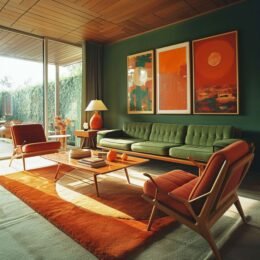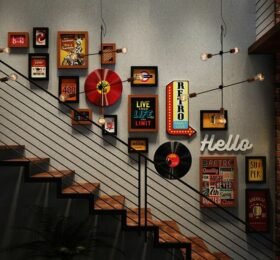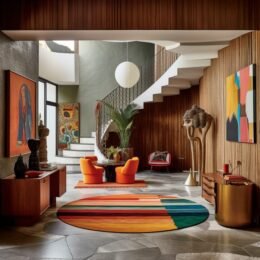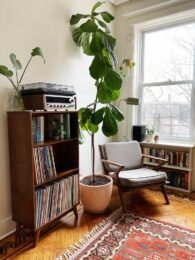Understanding the differences between retro and vintage styles can help you add personality and depth to your home decor. Although they both have nostalgic themes, they have different styles and vibes that can change your living area in different ways. In this article, we’ll look at the differences between retro and vintage from a home perspective, providing insights and examples to help you understand their distinct characteristics and make informed design decisions for your home. Understanding the differences between a funky, vibrant ambiance and a timeless, classic look will allow you to curate a home that reflects your personal style and preferences.
See also: Top 15 vintage bedroom design ideas
History of retro
Before people started using the word “retro,” designers were already taking inspiration from old styles. For example, back in the 18th and 19th centuries, there were movements like the Gothic Revival in architecture, where designers brought back elements from mediaeval times. Another example is the Neoclassical movement, which borrowed ideas from ancient Greek and Roman designs.
The term “retro” came about in the 1970s. It was first used in France to talk about looking back at the past. Specifically, people were interested in the fashion choices from World War II. So, “retro” became a way to describe this nostalgic feeling and the trend of bringing back old styles in a new way.
What is retro?
Retro colours are all about using bright and lively shades from the past in today’s designs. Unlike vintage colours, which are linked to certain times, retro colours can be made new and used now. They take ideas from cool design trends of the past, like the bold colours of the 1960s or the natural tones of the 1970s. Using retro colours can make your space feel nostalgic and lively, while still using modern colour techniques.

Source: Pinterest
Examples of retro
Furniture
- Get a mid-century modern sofa with clean lines and tapered legs, but in a bold mustard yellow fabric for that retro twist.
- Pair it with a plush burnt orange armchair with a chrome swivel base, reminiscent of the funky 1970s style.
- Add a modern coffee table made of glass and chrome with geometric designs to finish the whole thing and use that vintage Art Deco style.
Lighting
- Hang a sputnik chandelier with multiple glass globes, a popular choice from the mid-century era.
- Add a minimalist white mushroom lamp with a curved shade, inspired by Scandinavian design from the 1950s.
- For a touch of 1980s nostalgia, include a neon sign with a playful saying or pop culture icon.
Decor
- Install an attractive geometric rug with a black-and-white design that shows homage to the 1980s Memphis Group design movement.
- Arrange a selection of old record albums on a stand to infuse your room with a sense of musical history.
- Decorate your shelves with vibrant ceramic vases with abstract patterns inspired by mid-century modern pottery.
Accents
- Throw some pillows on your furniture with retro pop art prints, featuring bold colours and graphic elements.
- Find a vintage rotary phone in a vibrant shade like turquoise or red to add a touch of whimsy.
- Hang up a collection of vintage travel posters on the wall for a touch of wanderlust and retro charm.

Source: Pinterest
How to use retro for home?
- Don’t overdo it: Too much retro stuff can make your space look messy. Instead, pick a few standout pieces and let them be the stars of the show.
- Mix it up: Don’t feel like you have to stick to all retro items. It’s totally okay to mix in some modern furniture and gadgets too. This way, your space feels balanced and practical.
- Comfort is key: While retro furniture might look cool, make sure it’s comfy and suits your lifestyle. For example, that vintage armchair might look awesome, but it’s not worth it if it’s too uncomfortable to sit in for long periods.
- Start with accessories: Begin by adding small retro touches like throw pillows with funky patterns, a statement lamp with a classic design, or a vintage record player. These items can instantly infuse your space with retro charm without overwhelming it.
- Embrace bold colours: Retro style loves bold colours, so don’t be afraid to use them! Consider painting a statement wall in a vibrant shade like teal or mustard, or incorporate colourful artwork featuring geometric patterns to bring that retro vibe to life.
- Upcycle and repurpose: Get creative with upcycling and repurposing vintage finds. Give an old armchair a fresh look by reupholstering it in a funky fabric, repaint a thrift store lamp to match your retro theme, or create a gallery wall using vintage frames and prints. This way, you can breathe new life into old pieces while staying true to the retro aesthetic.

Source: Pinterest
History of vintage
Back in the day, folks didn’t really have the concept of “vintage” like we do now. They just wore their clothes until they couldn’t anymore! Especially if you didn’t have much money, you’d patch up your clothes or pass them down to keep using them. But then, in the 1920s, the word “vintage” started popping up. At first, it was used for fancy wines from specific years. As people got richer, they started seeing old stuff as cool, not just useful. So, stores selling second-hand things started getting popular because folks wanted unique stuff.
During World War I and II, when materials were scarce, people got super resourceful. They started appreciating older clothes that were made really well. And that’s when vintage clothes stores really took off. Then, in the 1960s, things changed big time. Young folks started digging through old clothes not just because they had to, but as a way to stick it to mainstream fashion and show off their own style. Vintage clothes became a symbol of being different and remembering the good old days.
What is vintage?
Vintage items are things from the past, usually between 20 to 99 years old. They’re special because they’re unique, not like things made today in big factories. Vintage stuff is often made better, with nicer materials and craftsmanship. They might have a few scratches or signs of use, but that just adds to their charm and makes them feel real. Vintage clothes and furniture bring the style of a certain time period into your home, letting you enjoy old fashion trends or design styles. Antique things are even older, usually over 100 years old, and are very valuable. Retro stuff, on the other hand, is new but made to look old-fashioned. It’s a fun way to bring old vibes into modern times.

Source: Pinterest
Examples of vintage
Home decor
- Get a comfy mid-century modern armchair with smooth lines and legs that slope.
- Brighten up your rooms with an old-fashioned Tiffany lamp that has a colourful stained-glass shade or a cool sputnik chandelier made of chrome and glass.
- Accessories: Show off your cute collection of mismatched teacups from the 1950s on a vintage tea tray.
- Put down a fancy Persian rug with fancy designs or a funky geometric rug that reminds you of the cool Memphis Group style.
- Hang up some old travel posters, colourful abstract paintings, or black-and-white photos to give your walls some character.
Fashion
- Dress up in a classic Levi’s denim jacket from the 1980s, a pretty floral maxi dress like they wore in the 1970s, or a smart wool suit from the 1950s.
- Spice up your outfits with a big knit scarf or a cool belt from the 1990s, some big sunglasses like they wore in the 70s, or a fancy vintage brooch to add some sparkle.
- Wear some funky geometric earrings inspired by the Art Deco style, a chunky Bakelite bracelet from the 1940s, or a long string of pearls that gives you that old Hollywood glam feeling.
How to use vintage for home?
- Make furniture stand out: Pick a cool vintage sofa or a classic dining table and chairs to be the stars of the room. Arrange them in a way that matches the old-timey vibe you’re going for.
- Set the mood with lighting: Choose retro lights like funky chandeliers, cool table lamps, or hanging lights with that old-fashioned feel. They can totally change the atmosphere of a room.
- Play with wallpapers and floors: Try out wallpaper with vintage patterns like flowers or fancy designs, or go for reclaimed wood floors to give your place a cosy, old-fashioned look.
- Don’t go with extra: Too much vintage stuff can make your space look messy. Just pick a few special pieces and let them shine.
- Mix old with new: It’s totally okay to mix vintage items with modern stuff. It keeps things interesting and makes your space feel balanced.
- Make sure it’s comfortable: Vintage furniture might look awesome, but it’s gotta be comfy too. Don’t sacrifice comfort for style – you want to enjoy using your space!

Source: Pinterest
FAQs
Increased focus on sustainability, easier authentication with technology, and the inclusion of late 20th and early 21st century items in the vintage category.
Look for materials and construction typical of the era, research hallmarks of specific styles, and consult experts for valuable pieces.
Absolutely! It allows for a personal touch and a more eclectic look.
Focus on functionality and comfort alongside aesthetics. Choose pieces you love and that reflect your personality to create a space that feels personal and stylish.
In general, vintage tends to be more affordable than true antiques, but it can still vary depending on the rarity, condition, and demand for a particular piece. Retro furniture is often more readily available and can be more budget-friendly, especially for mass-produced items.
Regular dusting, cleaning with gentle products, and avoiding harsh chemicals is key. Leather furniture might require special conditioners, while wood pieces might benefit from occasional polishing with appropriate oil. Research the specific care needs for different materials used in vintage furniture.
Vintage and retro styles can be incorporated into any room, depending on your taste and the overall feel you want to achieve. For kitchens and bathrooms, consider focusing on smaller vintage accessories or retro-inspired appliances. In bedrooms, vintage furniture like dressers for nightstands can add character. What's the future of vintage and retro?
How can I tell if something is truly vintage?
Is it okay to mix vintage and retro in the same space?
What should I prioritise when incorporating vintage or retro into my home?
Is vintage or retro more expensive?
How can I care for vintage furniture?
Is vintage or retro a good choice for all rooms in my house?
| Got any questions or point of view on our article? We would love to hear from you. Write to our Editor-in-Chief Jhumur Ghosh at jhumur.ghosh1@housing.com |

Sanskrati Gupta is an economics major currently pursuing her studies at Delhi University. She likes to explore world topics and share her thoughts and analysis through her writing.












